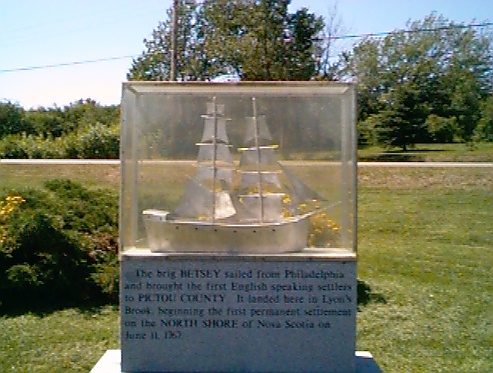| Lyons
Brook is located on the west side of the West River of Pictou County, Nova
Scotia. It was named after Rev. James Lyon an early Presbyterian
minister in the province. The first settlers to the area arrived
on the Betsy from Philadelphia in 1767 and settled on the Philadelphia
Grant.
A few years later a number of people from the Truro area would settle in Lyons Brook. Of these new settlers the most noteworthy was William Kennedy whose property was located at the mouth of what has since been known as Saw Mill Brook; where he erected in 1769 the mill from which the brook received its name. The mill was also the first framed building in the county. The first road in the Lyons Brook area was from the shore near the village to Scotch Hill. The next known road was constructed from the Saw Mill Bridge to the Ten Mile House. This road was known as the West River Road. John Mackenzie operated a quarry on the banks of the Saw Mill Brook and much of the stone was shipped to Halifax and Charlottetown. Some of the Lyons Brook stone was used in the Prince Edward Island Provincial Building in Charlottetown. In 1847 an American company took over the quarry and built a railway from the workings. This railway ran through a tunnel under Saw Mill Bridge and followed the shore on a long pier out to the channel. Carloads of stone from the quarry were hauled to the ships in the channel and ran over the rails by the force of gravity. The American Civil War would eventually put an end to the companies operations. In the 1840's James Kitchen and Fergus Fullerton built ships at various points along the shore. John Charles and Hugh Mackenzie operated a gristmill and sawmill in Lyons Brook in 1836. The first blacksmith was a man by the name of Clark, and Alfred Hogg opened the first carriage shop in Lyons Brook. The Tannery was the chief industry in the early years. The first being built and managed by John Logan. The first leather tanned was sold in Pictou, but for years the principal market was Truro. The business did well until the tannery was burned in 1875. It was rebuilt in the following year. The Tannery was the life of the community and gave work to more then one hundred men. The Tannery became well known throughout the Maritimes. Again the Tannery was burned, this time in 1911, destroying everything, but they rebuilt and were soon in business once more. The Tannery was also the first place in the community to have a telephone. The local people built Lyons Brook Community Hall in 1884 and the Orange Hall was built in 1904. The Orange Hall would latter be dismantled in 1935. Lyons Brook was unofficially known by a number of names. At different times it was called Tree Mile House, Logan's Tannery, West River Road, Harbour Head, Saw Mill Brook, and the Mi'kmaq called it "Nawegunicnk". |

   |